#Shenzhou 13
Text
Best of Discovery Season 1
This year the final season of Star Trek Discovery airs, bringing an end to the show that brought Star trek back to television after over a decade absense. To celebrate its 5 season run (which was incredibly long for a streaming show, I'll be doing a best of for all the seasons of streaming era trek so far, listing great moments/scenes (at least 13, as this was meant to be a bakers dozen series), and One honorable mention.

To start off, the season that Started it all, Star Trek Discovery Season One . Spoilers below
Battle of the Binary Stars

A fleet of Starfleet ships arrive to back up the USS Shenzhou against a klingon fleet, and what a fleet it is. A whole era of Starfleet design is explored in a single scene against a goreous backdrop of the titular binary stars.
2. U.S.S. Europa arrives
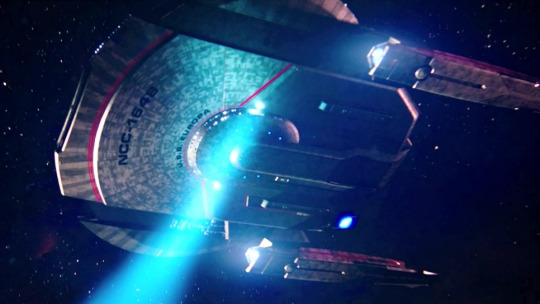
The U.S.S. Shenzhou is disable by the battle and is drifting towards an astroid when the Admiral's Flagship arrives. The Nimitz Class U.S.S. Europa arrives at the last second, tractoring the Shenzhou and calling a temporary ceasefire to the battle. It is a visually gorgeous scene with a wonderful score. For just a moment, the arrival of the mighty starship make it seem like everything might be okay.
3. U.S.S. Discovery arrives
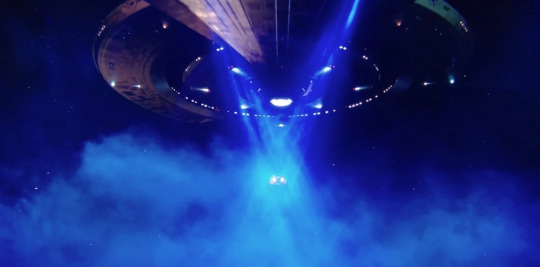
U.S.S. Discovery, the namesake off the show doesn't appear till episode 3, but she make a grand entrance, saving the prison shuttle transporting Burnham in a scene that wonderfully conveys her size and grandeur
4. The shushing Klingon
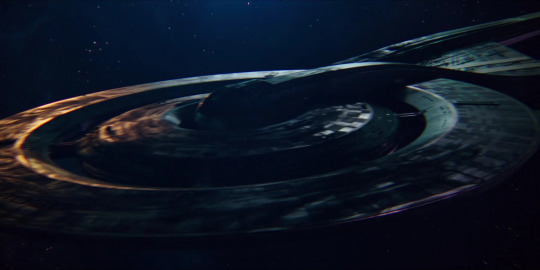
Aboard the damaged U.S.S. Glenn, a team from the U.S.S. Discovery find the crew fataly mutilated by a failed spore jump, but more immediatly threatening, a monster roams the halls of the stricken ship, one capable of killing the klingon boarding party sent to recover the ships secerts. The scenes onboard the Glenn are brutal, and wonderfully tense. It also gives us the hilarious "did that klingon just shush me?" Moment. (I chose a pic of the Glenn rather than the interior as those were more graphic than I wanted for this post)
5. The Discovery saves Corvan II

Discovery makes her first successful long range spore jump and saves the Federation mining Colony Corvan II. Its a wonderful moment od Discovery's crew coming together to save civilians.
6. Please Don't Take My Ship, She's All I Have Left

This moment between Cornwall and Lorca is amazing, and makes me wish that lorca hadn't been mirror Lorca. His plea for him to keep command off discovery is heartfelt (but later revealed to be for all the wrong reasons)
7. Mudd Loses

Magic to Make the Sanest Man go man is amazing throughout, but the moment the crew finally outwits Mudd is so, so satisfying.
8. The Loss of the USS Gagarin
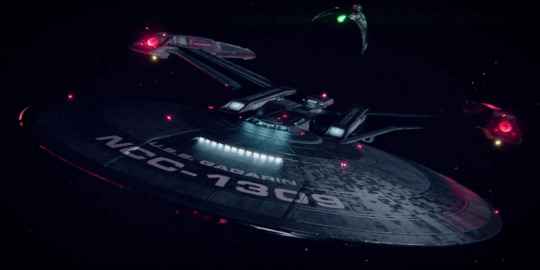
The Discovery attempts to save the U.S.S. Gagarin from the Klingopns and fails, despite their best efforts. The loss makes the war feel far more real, and highlights the fact the Discovery is just one ship, no matter her spore drive. I also love Lorca's speech here-"There will be time to grieve later"
9.Destruction of the Sarcophagus ship

A satisfying victory for the crew, and seeing discovery make all the jumps is an epic scene.
10.Mirror Tilly...kinda

"If you spoke to me that way I would cut out your tongue to lick my boots" What a line. Tilly taking on the role of her mirror counter part is amazing.
11. I.S.S. Shenzhou

The Mirror Shenzhou arrives, and she is beautiful. A former hero ships twisted mirror half.
12. Burnham kills Captain Connor

an amazing fight, and what a gut punch, as Burnham is forced to watch Connor die again, this time by her own hand. The crew clapping after the turbolift opens and his body falls out is chilling in the best way.
13. Reveal of the Imperial Palace

The I.S.S. Charon is an intimidating presense, and way cooler than a palace on a planet.
14. Destruction of the Charon and Discovery jumps Home
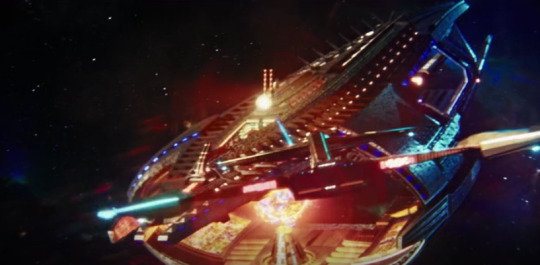
The bombing run Discovery makes on the Charon and her jump back to the prime universe using the resulting show wave is awesome, made even better on a personal layer by Burnham saving Mirror Georgiou-"I couldn't watch her die again"
15. Arrival at Qo'noS
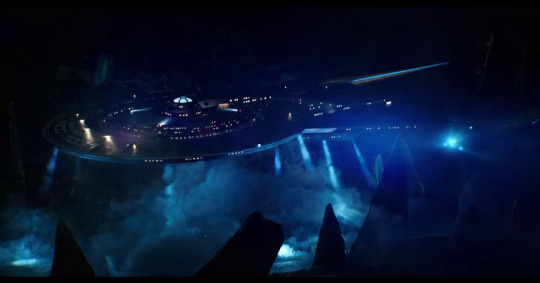
Discovery jumps to a cave on Qo'nos, and I love the weight of the scene. You can feel gravity grabbing the ship and Discovery struggling against it.
16. We are Starfleet

The scene the show has been building to, Burnham stands up to command over the plan to destroy the Klingon homeworld, and the crew backs her up.
17. U.S.S. Enterprise
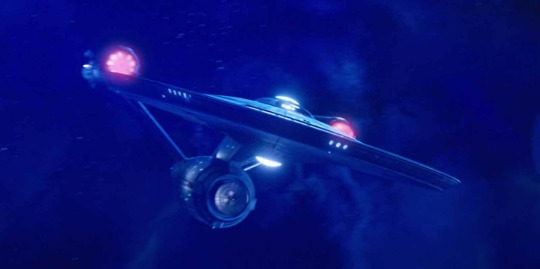
I remeber when I first saw her. The 1701 returned in all her glory. The TOS version is the definative U.S.S. Enterpise to me, but Discovery gave us an amazing earlier version. It had been decades since the prime 1701 had appeared on screen (we don't count certain series finalies) and its honestly still my favorite moment of the season.
Honorable mention: U.S.S. Discovery

the original teaser for the show showed a much different Discovery. While I understand this was never meant to be the final, I lover her all the same. It was also the moment Trek was back, after decades we had a new hero ship. I hope STO adds her someday, and that someone makes a model of her. She may not be the offical version, but she deserves love all the same.
#star trek#star trek discovery#star trek discovery appreciation post#USS Discovery#USS Enterprise#I don't own any of the screencaps#obviously
6 notes
·
View notes
Text
Star Trek: Eagle
NX-Class Ships of the War
NX-01 Enterprise: Launched in 2151 under the command of Captain Jonathan Archer, the Enterprise was the pride of Starfleet and one of the most important ships in the war.
NX-02 Columbia: Commanded by Captain Erika Hernandez and launched in 2154, the Columbia operated until 2156, when it was destroyed in the Battle of Algeron.
NX-03 Challenger: Launched in 2154 under the command of Captain Jeanette Gautier. Her mission took her to the borders of the Cardassian Union, where she laid the foundations for future cooperation between the First Republic and United Earth in the 23rd century.
NX-04 Discovery: Launched alongside the NX-03, Discovery was assigned to explore a region of space coreward of the Sol System, making first contact with the Saurian species and making formal contact with the Deltans. Under the command of Tomas Zamora, Discovery was instrumental in the Kzinti Campaign of the Earth-Romulan War.
NX-05 Atlantis: One of four NX-class vessels that were built as part of an accelerated shipbuilding campaign in the wake of the Romulan Crisis and launched in early and mid-2155 alongside the NX-06 Endeavor, NX-07 Apollo, and NX-08 Eagle. Under the command of Captain Brendan Harrington, it was assigned to deep space exploration before being recalled at the start of the Earth-Romulan War.
NX-06 Endeavor: Following the conclusion of the Xindi Crisis, the NX-06 Endeavor was assigned to explore the former Delphic Expanse. Under the command of Captain Hanabi Ozawa, Endeavor made contact with over a dozen species.
NX-07 Apollo: Commanded by Captain James Chen, the Apollo was originally assigned to explore planets just short of the Klingon border, but was quickly recalled at the beginning of the Earth-Romulan War.
NX-08 Eagle: Launched in mid-2155, the Eagle is considered the last of the "pre-war" NX-class spaceframes. Her original mission was to explore the region of space just beyond Mu Capricorni, but was recalled a few months later.
NX-09 Mercury: The first of the "war-era" NX spaceframes. Commanded by Captain Charles Collie, the Mercury was immediately sent to the frontlines near Bolarus.
NX-10 Vostok: The sister ship of the NX-09, the Vostok was launched under the command of Captain Timothy Bereza and assigned to Defense Group B, intercepting dozens of Romulan warships attempting to penetrate the defensive line.
NX-11 Gemini: Launched in July of 2157, the Gemini was under the command of Captain Samantha Clark, a descendant of the famous William Clark, and assigned to push the frontlines as far coreward as possible.
NX-12 Voskhod: Launched alongside the NX-11, the Voskhod, under the command of Michelangelo Ramirez, was assigned to Defense Group A, protecting the region coreward of the Sol System.
NX-13 Orion: The first of the last block of NX spaceframes ever built, launched in 2158 under the command of Captain Masaharu Sulu. The Orion, along with her sister ships, the NX-14 Orel, NX-15 Shenzhou, and NX-16 Gaganyaan, were launched weeks ahead of schedule during the Battle of Proxima Centauri.
NX-14 Orel: Launched ahead of schedule in 2158 under the command of Captain Albert MacKay, the Orel was destroyed in the Battle of Proxima Centauri.
NX-15 Shenzhou: Launched in 2158 to take part in the Battle of Proxima Centauri, the Shenzhou was lost along with her captain, Thomas Lau.
NX-16 Gaganyaan: Launched alongside the NX-13, NX-14, and NX-15, the Gaganyaan fought in the Battle of Proxima Centauri under the command of Captain Roy Khurana. It, along with the Orion, survived the battle and the lessons learned formed the basis of the major refit for the NX spaceframes in 2161.
3 notes
·
View notes
Link
During the last full week of April, forthcoming launches include two Starlink missions planned on Monday and Friday, and another two more Falcon 9 flights lifting customer satellites. The first of these is the delayed WorldView Legion 1 & 2 mission which was originally due to fly last week and is now scheduled for Wednesday. The first Starlink mission of the week will also see another milestone reached with the 300th landing of a Falcon 9 booster on the Group 6-53 mission. The fifth Electron to launch this year will carry two demonstration missions into two notably different orbits on Wednesday. One of the two demonstrations being hoisted by Rocket Lab is a demonstration of a novel solar sail developed by NASA and powered by the pressure of sunlight acting upon the surface of the sail. The week will also deliver a crewed launch on Thursday when the Shenzhou 18 mission sends three more taikonauts to the Tianhe core module of China’s Tiangong space station. The number 13 resonates this week, with Shenzhou 18 being the 13th crewed mission of the Chinese space program, and Falcon 9 looking on course to repeat its current record of 13 flights in a month. This is reliant on the Galileo satellite mission, which has not yet been given a firm launch time and is currently scheduled to fly no earlier than Sunday, April 28. B1060 will be making its 20th and final flight and was the first booster to be recovered 13 times back in June 2022. This will be the first time a Falcon 9 single first stage has been expended since November 2022. Assuming the Galileo mission does launch this week, it will be the 82nd orbital launch of the year. This is 18 more than the count on the equivalent date last year, and largely due to SpaceX’s remarkable Falcon 9 launch cadence. Coincidentally 13 years ago this week Shuttle Endeavour was also ready on the pad for its final mission (STS-134), and the penultimate one for the Shuttle program. A malfunction on one of the auxiliary power units caused the launch to be scrubbed and delayed into May, however. This time last year there had also been the same number of Starship launches for the year so far — it’s been over a year now since Starship’s maiden flight back on April 20, 2023, on the IFT-1 mission. It is also ten years this week since the company achieved the first successful propulsive ocean touchdown of a liquid rocket engine orbital booster on the CRS-3 mission and the first Falcon 9 which flew with landing legs. Booster B1076-12 landed on droneship Just Read the Instructions, during the Eutelsat 36D mission in March 2024. (Credit: SpaceX) Falcon 9 Block 5 | Starlink Group 6-53 The first Starlink mission of the week is scheduled to launch from SLC-40 at the Cape Canaveral Space Force Station on Monday, April 22 at 6:40 PM EDT (22:40 UTC). The payload is another batch of 23 Starlink v2 Mini satellites massing around 16,800 kilograms and heading into an initial 285 by 293-kilometer orbit, inclined by 43 degrees. The booster for this mission has not yet been declared but is expected to land on the autonomous droneship Just Read the Instructions around 604 kilometers further downrange, while support ship Bob will recover the fairings. Significantly this will be the 300th landing of a Falcon 9 booster, and the 226th since the last unsuccessful one. These Group 6 missions continue, at least for the time being, to launch in numerical order except the missing Group 6-50 mission which remains unscheduled at present. This will be the 158th launch dedicated to Starlink overall and the 84th for the Gen2 series. SpaceX has successfully launched 24 Starlink satellites in a single batch in the past and has declared a desire to extend this number further to 28 in a single batch by the end of the year. Starlink launches from the east coast are expected to focus on this pad soon while LC-39A is prepared for the GOES-U launch on Falcon Heavy in June. As the week begins and before this flight, SpaceX has launched a total of 6,258 Starlink satellites, of which 406 have re-entered and 5,206 have moved into their operational orbit. Electron is prepared at LC-1 in Mahia Peninsula. (Credit: Rocket Lab) Electron / Curie | Beginning of the Swarm Rocket Lab is due to launch the fifth Electon of the year and its 47th mission overall on Wednesday, April 24 for the Beginning of the Swarm mission. Lift-off is scheduled at the start of an 85-minute window at 09:30 NZST (21:30 UTC on the 23rd) from pad LC-1B in the Mahia Peninsula of New Zealand. Two different payloads are sharing a ride for this mission. Firstly, NeonSat-1 is a demonstration mission ahead of the planned constellation of high-resolution optical satellites which would begin to launch from 2026 onward. The satellite was developed by the Korea Advanced Institute of Science and Technology and its Satellite Technology Research Center which launched Korea’s first satellite (KITSAT-1) 32 years ago. This Earth observation satellite will monitor natural disasters along the Korean peninsula, applying artificial intelligence to its high-resolution imagery. It will be deployed 50 minutes into the mission into a circular orbit at 520 kilometers in altitude. Electron’s Kick Stage will then light its Curie engine to raise its altitude to 1,000 kilometers, with a second burn to then circularize the orbit where it will deploy a second payload one hour and 45 minutes into the mission. Render of NASA’s ACS3 Solar Sail in orbit. (Credit: NASA) This is another technology demonstration, developed by NASA’s Ames and Langley Research Centers. This Advanced Composite Solar Sail System (or ACS3) technology demonstration will deploy a solar sail from a cubesat using lightweight booms made from composite materials. As the name implies, this sail will leverage light from the sun and will be propelled by the pressure of sunlight acting upon it. The spacecraft will spend a couple of months in an initial flight and checkout phase before deployment of the booms and reflective sail. The craft needs to be at a sufficient altitude for the tiny force of sunlight that will be applied to the sail to overcome atmospheric drag. At this altitude, this force is said to be roughly equivalent to the weight of a paperclip resting on your palm. The craft will then perform a series of pointing maneuvers to demonstrate orbit raising and lowering which will span weeks, so it could be July or later before any results are known. It is intended that the data from this mission informs the creation of larger solar sails that could efficiently propel satellites for several usages such as communications relays on future crewed exploration missions, early warning satellites, or reconnaissance missions such as to near-Earth asteroids. Reducing mass could help to eliminate heavy propulsion systems and make longer-duration missions more efficient in both energy and cost. The kick stage will fire its engine retrograde one final time to lower its orbit, enabling atmospheric drag to eventually complete the task of deorbiting it, where it will burn up on re-entry. This mission required the addition of extra propellant tanks, extra batteries, and larger gas bottles for the reaction control system on the kick stage. Rocket Lab is moving closer toward the reuse of a recovered Electron first stage. The company announced in early April that the carbon composite first-stage Electron recovered from the Four of a Kind mission in January has entered the production line for final acceptance testing and qualification ahead of a reflight. Encapsulation complete for our 47th mission! NEONSAT-1 (@KAISTPR) and ACS3 (@NASA) are now safely enclosed within Electron’s fairing. The next time this nose cone opens up, these two satellites will be in space! ‘Beginning Of The Swarm’ Mission info: https://t.co/xyg2Ghty8K pic.twitter.com/i25zKlUqNs — Rocket Lab (@RocketLab) April 18, 2024 Falcon 9 Block 5 | WorldView Legion 1 & 2 A Falcon 9 was originally scheduled to launch from SLC-4E at Vandenberg Space Force Base last week on April 17, carrying two satellites massing a total of 1,500 kilograms into a Sun-synchronous orbit. This flight was postponed the day before launch, however, and is now scheduled for this Wednesday, April 24 at the start of a four-and-a-half-hour window at 11:30 AM PDT (18:30 UTC). The booster, which has yet to be confirmed, is expected to return to land on the pad at Landing Zone 4 located around 400 meters away from the launch mount. The WorldView Legion satellite constellation is Maxar Technologies’ next-generation constellation of Earth observation satellites, designed and built in-house at the company’s facilities in Palo Alto and San Jose, California. DigitalGlobe, which was later taken over by Maxar, first announced its selection of SpaceX as the launch provider back in 2018 when the satellites were initially anticipated to launch in two blocks of six. Hardware-based delays, as well as the complexity of the technology, have caused several setbacks. The planned constellation will now consist of six satellites in total, to be launched in pairs and will orbit in polar and mid-inclination orbits. The satellites are the first to utilize a new Maxar 500 series bus platform with better stability, agility, and pointing accuracy. They will occupy an approximately 500-kilometer altitude orbit when fully deployed, providing 30-centimeter high-resolution imagery and eight-band multispectral imagery across 15 revisits per day over the most active regions of the world. The satellites will triple the company’s coverage in 30-centimeter class resolution, capturing five million square kilometers of imagery each day. The satellites are designed with a 10-year lifespan. With @RTX_News, we developed a new telescope for the WorldView Legion satellites. They collect the high-quality images that customers have come to expect from us, but the telescope is smaller and requires less power.More details: https://t.co/PKttctsC39#ittakesalegion — Maxar Technologies (@Maxar) April 11, 2024 Applications will include supporting national security missions for monitoring and surveillance of ground-based potential threats or verifying enforced sanctions and treaties. The satellites also provide a variety of maritime monitoring functions such as the surveillance of natural disasters, pollution, and oil spills through to the detection of illegal fishing, piracy, drug smuggling, or human trafficking. Utilizing artificial intelligence algorithms, the WorldView Legion satellites can support the ability to detect, identify, and respond quickly to suspicious activities. Maxar worked with its instrument partner Raytheon to develop a smaller telescope that requires less power. Chang Zheng 2F/G | Shenzhou 18 China is sending three more taikonauts from the People’s Liberation Army Astronaut Corps to the Tianhe core module of China’s Tiangong space station on Thursday, April 25. Lift-off is expected near the start of a 40-minute launch window at 12:59 UTC from Site 901 (SLS-1) at the Jiuquan Satellite Launch Center. The crew is expected to arrive at the space station around seven hours later. Shenzhou 18 will be the 18th mission of the Shenzhou (“divine craft”) program and the 13th of these to be crewed. As with other missions in this series, the vehicle will be the Chang Zheng 2F which is a human-rated two-stage version of the 2E, which itself was derived from the 2C. The vehicle was rolled to the pad last week on April 17. Shenzhou 18 CZ-2F/G rolled out to the pad – April 2024: (Credit: CCTV) Active since October 2011, the Chang Zheng 2F/G first launched crew for Shenzhou 8 and this vehicle is flying for the first time this year. It has been over 20 years since Shenzhou 5 launched the first crewed mission for the Chinese space program, becoming the third country in the world to achieve independent human spaceflight. The names of the taikonauts are expected to be revealed at a press conference the day before launch, however, it is anticipated that the commander will be Ye Guangfu who has 182 days of experience in space and previously flew on Shenzhou 13. The taikonauts from Shenzhou 17 have been on the station since last October and are expected to return to Earth in the last few days of April, following a handover ceremony. Falcon 9 Block 5 | Starlink Group 6-54 The second Starlink mission of the week is scheduled to launch from SLC-40 at the Cape Canaveral Space Force Station on Friday, April 26. Lift-off is expected at 6:40 PM EDT (22:40 UTC). Neither the booster nor the droneship have been confirmed yet at the time of publishing, nor the number of Starlink v2 Mini satellites in the payload. Falcon 9 Block 5 | Galileo FOC FM25 & FM 27 In the wake of Starlink Group 6-53 delivering SpaceX’s 300th booster landing earlier this week, this mission will not be attempting a landing and will instead be expending booster B1060 on its 20th and final flight. This booster has supported numerous Starlink missions into Groups 4, 5, and 6 as well as Transporter 6, Galaxy 33 & 34, and the IM-1 mission launching the Nova-C lander, Odysseus. With the company’s continual increase in both launches and recoveries, expending boosters have become rarer. Four months ago, the Falcon Heavy center core B1084 was the last for which there was no recovery attempt on the USSF-52 mission in late December. The last time a single Falcon 9 first stage was expended dates further back to late November 2022 when B1049 was expended on the Eutelsat 10B mission. Booster B1051, which coincidentally launched Galaxy 31 & 32, was also expended just 11 days prior and had continually set milestones as the first booster to be recovered eight, nine, ten, 11, and 12 times. Lift-off for this mission is scheduled for no earlier than Sunday, April 28 from LC-39A at the Kennedy Space Center in Florida. The payload is a pair of satellites massing 1,603 kilograms for the European Space Agency’s (ESA) Galileo constellation targeting a medium-Earth orbit at 23,616 km altitude. Initially expected to be launched on a Soyuz, then moved to the delayed Ariane 6, ESA finally contracted SpaceX to lift this long-delayed payload. Rubidium Atomic Clock development at Leonardo’s headquarters in Nerviano, Milan. (Credit: ESA) This global navigation satellite system is named after Italian astronomer Galileo Galilei and went live in 2016 with the intention that European nations do not have to rely on the US GPS or Russian GLONASS platforms. Usage of the lower precision services is open and free to access, while the higher-precision services have 1-meter precision for positioning and are a paid-for service. These satellites begin to build the next generation of the constellation which will replace older equipment, with the completed constellation hosting 10 satellites in each of three planes. Atomic clocks are a critical pillar in satellite navigation and are already utilized on satellites in this constellation. ESA recently signed a €12 million contract with Leonardo S.p.A to design, develop, and qualify a new technology for pulsed optically pumped rubidium atomic clocks. These experimental models will fly alongside the currently operational clocks used for Galileo services while they undergo in-orbit verification. This could be the last or the penultimate launch from LC-39A before it is reconfigured for Falcon Heavy which is expected to lift the GOES-U mission in late June. These preparations can typically leave a gap of around 40 to 50 days between the previous use of the pad and a Falcon Heavy launch. (Lead image: Render of NASA’s ACS3 Solar Sail render in orbit with sunrise. Credit: NASA) The post Launch Roundup: SpaceX to land its 300th booster, NASA tests a solar sail, and China launches three more taikonauts appeared first on NASASpaceFlight.com.
0 notes
Text
Space habitat reports – Feb.13.2024
Here is this week's selection of videos and news items about space habitats, living in space, and space settlement. Starts with NASA's latest Space to Ground report for the International Space Station:
https://youtu.be/pKeQBA_TdOI
** Progress MS-24 undocking - SciNews
The Progress MS-24 spacecraft autonomously undocked from the aft port of the Zvezda service module, on the International Space Station, on 13 February 2024, at 02:09 UTC. Progress MS-24 (ISS Progress 85 mission) delivered about three tons of food, fuel and supplies for the Expedition 69 crew aboard the International Space Station.
Credit: Roscosmos
Music: “Waltz of the Flowers by Tchaikovsky” courtesy of YouTube Audio Library
https://youtu.be/rRHukuFyGuM
** ISS astronauts toss football, mention Taylor Swift in Super Bowl prep on space station - VideoFromSpace
NASA astronauts Loral O'Hara and Jasmin Moghbeli talk about the Super Bowl and "Swiftly come up to speed" in this pre-game video.
https://youtu.be/B3leb3TZ3oU
** Expedition 70 Space Station Crew Answers Massachusetts Student Questions - Feb. 9, 2024 - NASA Video
Aboard the International Space Station, NASA Expedition 70 Flight Engineer Loral O’Hara and ESA (European Space Agency) astronaut Andy Mogensen discussed living and working in space during an in-flight event Feb. 9 with students attending the Central Tree Middle School in Rutland, Massachusetts. O’Hara and Mogensen are in the midst of a science mission living and working aboard the microgravity laboratory to advance scientific knowledge and demonstrate new technologies. Such research benefits people on Earth and lays the groundwork for future human exploration through the agency’s Artemis missions, which will send astronauts to the Moon to prepare for future expeditions to Mars.
https://youtu.be/dfhfJV7empg
** European Space Agency (ESA) news:
- Marcus Wandt returns to Earth after his first spaceflight | ESA - Feb.9.2024
- Third NASA Enabled Private Flight to Space Station Completes Safely | NASA - Feb.9.2024
- Final flight of Muninn | ESA - Feb.9.2024
- Muninn Mission highlights | ESA - Feb.8.2024:
https://dlmultimedia.esa.int/download/public/videos/2024/02/006/2402_006_AR_EN.mp4
--- Day and night cycle on the Space Station | ESA - Feb.8.2024
https://dlmultimedia.esa.int/download/public/videos/2024/02/009/2402_009_AR_EN.mp4
** Ax-3 Mission | Return - Axiom Space
Axiom Space is building for beyond, guided by the vision of a thriving home in space that benefits every human, everywhere. The leading provider of human spaceflight services and developer of human-rated space infrastructure, Axiom Space operates end-to-end missions to the International Space Station today while developing its successor, Axiom Station – the world’s first commercial space station in low-Earth orbit, which will sustain human growth off the planet and bring untold benefits back home. For more information about Axiom Space, visit www.axiomspace.com.
https://www.youtube.com/live/15qPwAm0G9Y
** Happy Chinese New Year from the Tiangong space station crew - VideoFromSpace
The Shenzhou 17 crew Tang Shengjie, Tang Hongbo and Jiang Xinlin wish everyone a Happy Chinese New Year from the Tiangong space station.
https://youtu.be/OGfDgdKdRrc
See also China’s Space Station Crew: Celebrating Year of the Dragon | Leonard David - Feb.12.2024
** Other news and articles:
- Crew Conducts Stem Cell Research and Training as Cargo Craft Nears Launch | Space Station/NASA - Feb.12.2024
- A New Frontier for Architects: Dr. Ariel Ekblaw and the Evolution of Space Exploration | NCARB - National Council of Architectural Registration Boards - Jan.16.2024
** Highlight: The artwork that is The Appalachians Feb 6, 2024 - 12:16 EST - ISS Above
NASA EHDC6 Live views of the Earth from the International Space Station
https://youtu.be/_FjcOdPFpVQ
** Highlight: SoCal - Los Angeles - San Diego - Feb 10, 2024 15:21 PST - ISS Above
https://youtu.be/fsXgE-Kagx8
** Live Video from the International Space Station (Official NASA Stream) - NASA
Watch live video from the International Space Station, including inside views when the crew aboard the space station is on duty. Views of Earth are also streamed from an external camera located outside of the space station. During periods of signal loss due to handover between communications satellites, a blue screen is displayed.
The space station orbits Earth about 250 miles (425 kilometers) above the surface. An international partnership of five space agencies from 15 countries operates the station, and it has been continuously occupied since November 2000. It's a microgravity laboratory where science, research, and human innovation make way for new technologies and research breakthroughs not possible on Earth. More: https://go.nasa.gov/3CkVtC8
Did you know you can spot the station without a telescope? It looks like a fast-moving star, but you have to know when to look up. Sign up for text messages or email alerts to let you know when (and where) to spot the station and wave to the crew: https://spotthestation.nasa.gov
https://www.youtube.com/live/xAieE-QtOeM?feature=share
====

ISS after undocking of STS-132
=== Amazon Ads ===
Lego Ideas International Space Station
21321 Toy Blocks, Present, Space, Boys, Girls, Ages 16 and Up
====
Outpost in Orbit:
A Pictorial & Verbal History of the Space Station
Read the full article
0 notes
Text
Ruixing has gone through a magical first half of his life

The protagonist of this magical HE Tuber business history is undoubtedly Ruixing.
Luckin, since its establishment in 2017, has gone through a magical six years of "starting off and running - getting stuck in the quagmire - and turning against the wind."
In the initial stage, we ran blindly, and it only took 18 months from opening the first store to going on the market;
The company was mired in financial fraud, and it only took 13 months from listing to delisting;
Return of the King made a comeback against the wind, and it took 21 months from delisting and suspension to achieving profit for the first time.
Over the past six years, Luckin has stood in the media spotlight again and again. The magical first half of his life must be worth recording with several times the volume of the Muddy Waters short-selling report, and record this special business storm with magical, absurd and thrilling writing methods.
1. In the initial stage, running blindfolded
This is the story before delisting.
Going back to October 28, 2017, Luckin opened its first store in Galaxy SOHO, Beijing.
At that time, the elevators of major office buildings and residences in first-tier cities were covered with promotional posters of the two brand spokespersons Tang Wei and Zhang Zhen. The "Luckin Blue" in sharp contrast with "Starbucks Green" was impressive. That classic sentence The brand slogan "Who doesn't love this cup" has the effect of brainwashing but also quite favorable.
Luckin's initial promotion strategy was quite characteristic of Chinese Internet companies at the time, burning money quickly and opening stores crazily, hoping to trade scale for market. In just half a year, Luckin has achieved jaw-dropping store opening results: On May 8, 2018, Luckin held a press conference at the National Convention Center to announce its official opening. At this time, the number of stores had reached 525.
Luckin is positioned as “Internet Coffee”.
In other words, Luckin has brought a new coffee consumption model: consumers first place an order and complete the payment on the mobile app or mini program, and then go to the store to pick it up. This has become a typical case of a new retail model that combines online and offline.
On the mobile phone, Luckin followed the "Shenzhou" promotion model of founders Lu Zhengyao and Qian Zhiya at the time, attracting new customers through high subsidies, and using consumers' social circles to engage in fission marketing. As early as during the promotion of Shenzhou's special car, Lu Zhengyao's team verified the feasibility of "playing fission with subsidies". This method of play has made great contributions to the growth of Luckin's user scale;
On the store side, Luckin no longer provides a "Starbucks-style" social experience space. There are no seats for professionals to slowly chat about business and work while enjoying the aroma of coffee. It uses only a few square meters of space to carry an average of hundreds of cups of sales per day.
It was all radical, a bit carried away by the "desire to succeed".
In 2018, Luckin added 2,064 self-operated stores, 281 in the first quarter, 334 in the second quarter, 565 in the third quarter, and 884 in the fourth quarter (the data in each news report are different, this data comes from People's Daily Online ), the number and speed of opening stores is crazy.
At the same time, store operating costs have also increased simultaneously. In the first quarter of 2019, Luckin’s store opening speed has been slightly sluggish.
The prospectus shows that in the first quarter of 2019, Luckin Coffee’s store rent was 100 million yuan, an increase of 39% from the previous quarter, but the number of stores only increased by 14%. In order to obtain enough funds to sustain expansion, Luckin continued to look for financing and quickly landed on Nasdaq.
Luckin got what it wanted and created a speed myth in the capital world.
Relying on the label of "Shenzhou Series", it completed a US$200 million Series A financing within half a year, with a post-money valuation of US$1 billion; and then completed a US$200 million Series B financing, with a post-money valuation of US$2.2 billion. , becoming the fastest growing unicorn in China.
On May 17, 2019, Luckin rang the bell of the Nasdaq in the United States. From its establishment to listing, it only took Luckin 18 months, setting a new record for the fastest listing of Chinese Internet companies.
At that time, Ruixing took on Starbucks in a high-profile manner.
In May 2018, the same year and month when Luckin announced its official business, Luckin issued an open letter to Starbucks China, accusing Starbucks of being "suspected of monopoly" and saying that Starbucks "contains exclusivity clauses in contracts with many properties" and "has no influence on suppliers." Partners frequently put pressure to take sides.” Later, Starbucks responded that it had "no intention to participate in the market hype of other brands." The outcome of this public case was that Luckin unilaterally withdrew the lawsuit.
It is true that Ruixing really wants to catch up with Starbucks’ popularity, just like now C
0 notes
Text
Events 11.19 (after 1950)
1950 – US General Dwight D. Eisenhower becomes Supreme Commander of NATO-Europe.
1952 – Greek Field Marshal Alexander Papagos becomes the 152nd Prime Minister of Greece.
1954 – Télé Monte Carlo, Europe's oldest private television channel, is launched by Prince Rainier III.
1955 – National Review publishes its first issue.
1967 – The establishment of TVB, the first wireless commercial television station in Hong Kong.
1969 – Apollo program: Apollo 12 astronauts Pete Conrad and Alan Bean land at Oceanus Procellarum (the "Ocean of Storms") and become the third and fourth humans to walk on the Moon.
1969 – Association football player Pelé scores his 1,000th goal.
1977 – TAP Air Portugal Flight 425 crashes in the Madeira Islands, killing 131.
1979 – Iran hostage crisis: Iranian leader Ayatollah Ruhollah Khomeini orders the release of 13 female and black American hostages being held at the US Embassy in Tehran.
1984 – San Juanico disaster: A series of explosions at the Pemex petroleum storage facility at San Juan Ixhuatepec in Mexico City starts a major fire and kills about 500 people.
1985 – Cold War: In Geneva, U.S. President Ronald Reagan and Soviet Union General Secretary Mikhail Gorbachev meet for the first time.
1985 – Pennzoil wins a US$10.53 billion judgment against Texaco, in the largest civil verdict in the history of the United States, stemming from Texaco executing a contract to buy Getty Oil after Pennzoil had entered into an unsigned, yet still binding, buyout contract with Getty.
1985 – Police in Baling, Malaysia, lay siege to houses occupied by an Islamic sect of about 400 people led by Ibrahim Mahmud.
1988 – Serbian communist representative and future Serbian and Yugoslav president Slobodan Milošević publicly declares that Serbia is under attack from Albanian separatists in Kosovo as well as internal treachery within Yugoslavia and a foreign conspiracy to destroy Serbia and Yugoslavia.
1994 – In the United Kingdom, the first National Lottery draw is held. A £1 ticket gave a one-in-14-million chance of correctly guessing the winning six out of 49 numbers.
1996 – A Beechcraft 1900 and a Beechcraft King Air collide at Quincy Regional Airport in Quincy, Illinois, killing 14.
1998 – Clinton–Lewinsky scandal: The United States House of Representatives Judiciary Committee begins impeachment hearings against U.S. President Bill Clinton.
1999 – Shenzhou 1: The People's Republic of China launches its first Shenzhou spacecraft.
1999 – John Carpenter becomes the first person to win the top prize in the TV game show Who Wants to Be a Millionaire?.
2002 – The Greek oil tanker Prestige splits in half and sinks off the coast of Galicia, releasing over 76,000 m3 (20 million US gal) of oil in the largest environmental disaster in Spanish and Portuguese history.
2004 – The worst brawl in NBA history results in several players being suspended. Several players and fans are charged with assault and battery.
2010 – The first of four explosions takes place at the Pike River Mine in New Zealand. Twenty-nine people are killed in the nation's worst mining disaster since 1914.
2013 – A double suicide bombing at the Iranian embassy in Beirut kills 23 people and injures 160 others.
2022 – A gunman kills five and injures 17 at Club Q, a gay nightclub in Colorado Springs, Colorado.
1 note
·
View note
Link
0 notes
Text
0 notes
Text
Wentian experimental module successfully finished rendezvous with China Space Station
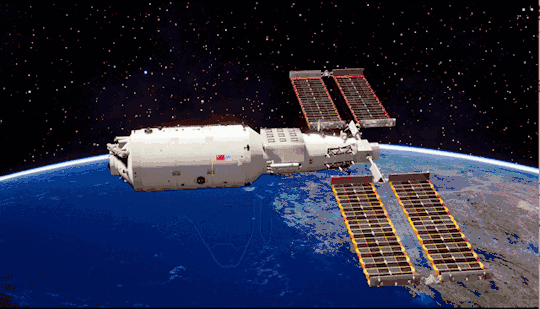
Lack of "Soft Force" is indispensable! Wentian experimental module successfully finished rendezvous with China Space Station.
You are welcome to visit our download centre to check Soft Force of E-catalogues or watch our video centre to check more projects.
At 14:22 on July 24, 2022, the Long March 5 B yao-3 carrier rocket was successfully launched, putting the experimental module into the scheduled orbit accurately. In space, the Wentian experimental module successfully docked with the Chinese space station assembly, and the flexible solar wing completed the second deployment. The whole rendezvous process lasted about 13 hours.
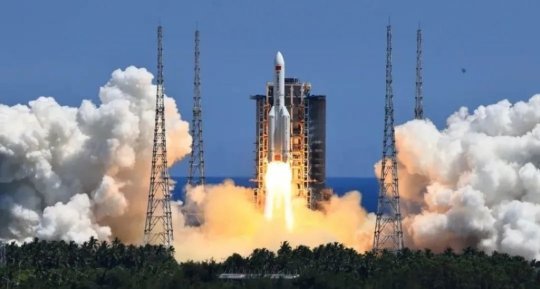
The successful rendezvous of Wentian experimental module is a comprehensive embodiment of the innovation and application of the most cutting-edge technology in many domestic disciplines. Among them, the successful deployment of the soft solar wing carried by the Wentian experimental module in orbit is an important symbol of the successful launch mission.

This is the longest and largest flexible solar wing in China at present. After the wings are fully deployed, it can reach 55 meters, setting a new record for China's spacecraft to use solar panels in orbit. The solar wing is only a little harder than clothes, and it adopts double axis Soft Force control. Without adjusting the attitude of the cabin, it can adjust the orientation at any time. It can track the sun with two degrees of freedom. The average power generation per day is more than 430kw, making the experimental cabin a veritable "main power station" to continuously supply power to the assembly.
In the mission of the "ask the sky" experimental module, Professor Song , who is currently the executive president of a space science and Technology Research Institute, and his doctoral team were responsible for participating in the development of the push-pull measuring sensor and measuring instrument for the push-pull rod of the flexible solar wing, which played an extremely important role in the successful development of the flexible solar wing in orbit,Soft Force.

Over the years, Professor Song has led his professional team to undertake national manned space engineering projects for many times. In the Shenzhou 13 manned mission on April 16, 2022, the team developed the space station astronauts' in orbit operating Soft Force measurement sensor and measurement equipment, completed the astronauts' in orbit finger pinch force, hand grip force, push and pull force, hand multi-dimensional force and foot multi-dimensional force and other accurate measurements, and obtained important measurement data such as human operating force and biomechanics in microgravity environment, It strongly supports the research on the change law of the operating Soft Force of Chinese space station mission astronauts under the typical attitude of long-term in orbit.
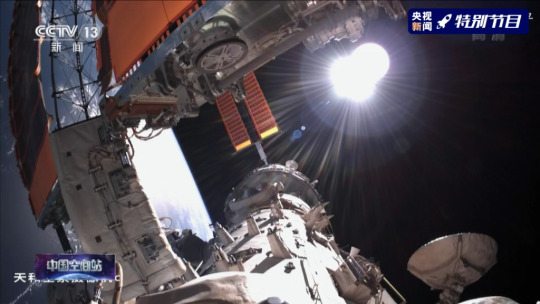
As a leader in the field of force and touch in China, Professor Song also served as the chief scientific adviser of Tallman robotics, providing a steady stream of important technical support for TM in the R & D and innovation process of precision Soft Force control technology. In 2018, the technical team jointly developed the leading softforce in China ® Precision force control technology has created the highest force control accuracy of ± 0.01N in the industry, filled the domestic technical gap, opened up a unique basic cutting-edge control technology route and continued to accumulate and extend.
At present, the precision Soft Force control technology based on the model prediction algorithm has been iteratively upgraded to version 2.0, which realizes the compliant force control during the movement of the actuator, real-time force feedback, and constant output without overshoot under high-speed movement, making the motion mode of the actuator more intelligent and refined, so as to improve the production yield and high inspection pass rate of precision parts.
With a series of precision force controlled hardware actuators launched by TM as the carrier, softforce ® 2.0 precision Soft Force control technology is widely used in 3C electronics, semiconductors, automobiles, medical treatment, lithium batteries, Aerospace Military Industry and other fields with increasingly high requirements for precision manufacturing, including but not limited to various new intelligent products, new materials, new technology carriers and their core components, such as fine assembly, press fitting, flexible polishing, precision testing and other core processes, to help integrators and end users provide diversified Practical precision force control solution.
Tallman robotics has never stopped its multi-dimensional research on mechanical mechanism, algorithm, Soft Force control, drive and bionics of force control and force touch. In March 2022, TM, Professor Song and his doctoral research team jointly broke through a disruptive technological innovation in precision Soft Force control technology - Soft humanoid actuator, which can implement high-sensitivity force control without force sensor, eliminate the influence of friction, and be compatible with large and small output. This future oriented technology provides the feasibility of a new type of force control execution for metauniverse, teleoperation, etc.
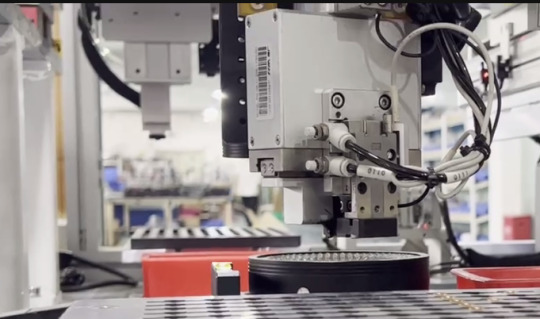
Thanks to the efforts of scientists, China's space industry has constantly reached new heights, making every rocket launch an expected event. The innovation and breakthrough of science and technology is bound to promote the rapid development of China's industry, science, medicine and other fields, changing with each passing day.
However, Tallman robotics Soft Force control technology is still in the primary development stage in China, and there is a wide space for exploration and application. Based on its original technological advantages, TM will integrate the strength of enterprises and academic research, provide a wider range of innovative precision Soft Force control technologies, products and solutions for industrial automation, and help China's "smart" manufacturing.
Read the full article
0 notes
Text
UPDATED: CHINA'S WENTIAN LAB MODULE DOCKS WITH TIANGONG SPACE STATION
UPDATED: CHINA’S WENTIAN LAB MODULE DOCKS WITH TIANGONG SPACE STATION
China’s Wentian lab module docked with the Tianhe core module after about 13 hours following its launch, China Manned Space Agency reported. This is the first time that rendezvous and docking has been carried out during the period when astronauts are currently stationed in orbit.The Shenzhou-14 crew currently in the core module will then enter the Wentian cabin. They will become the first Chinese…
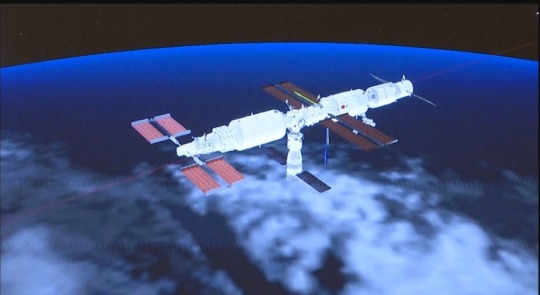
View On WordPress
0 notes
Link
This week nearly saw two secret spaceplanes launched within days of each other. After ground systems concerns and then weather delays, the US Department of Defense’s X-37B vehicle had its OTV-7 launch on the Falcon Heavy USSF-52 mission scrubbed from its initial planned attempt on Dec. 11. Starlink Group 6-34 was also scrubbed that same day and again a day later due to high-level ground winds, during what turned out to be quite a volatile week for planned launches. As we go to press, a double header looks to be back on, this time on the evening of Dec. 28 with both a Falcon Heavy and a different Falcon 9 launch scheduled within five hours of each other. If the current schedule stays as-is, this Falcon 9 flight, Starlink Group 7-9, will be SpaceX’s 300th mission and poignantly its last of this year. China launched two of its tallest active rockets this week within a fraction over 24 hours of each other. The Chang Zheng 2F/T launched China’s own equally secretive CSSHQ spaceplane on Dec. 14 for its third flight. This was followed the next day by the first and only launch this year of a Chang Zheng 5 carrying the Yaogan 41 reconnaissance satellite from the Wenchang space launch center into a high elliptical orbit. At 52 and 57 meters tall, respectively, these are beaten in height by the less frequently flown Chang Zheng 2F/G at 58.3 meters. This is next slated to launch the crewed Shenzhou 18 mission to the Tianhe core module of the Tiangong space station in May next year. A third Chinese mission launched another experimental craft three days later when a Hyperbola 1 Y7 took a reusable cargo spacecraft on its first orbital test for AZSPACE’s DEAR-1 mission. Conical in shape, this craft is designed to take up to 300 kilograms for up to a year in orbit. The Hyperbola rocket family has been a focus this last week following the release of video from the Hyperbola-2Y hop test, and pathfinding for the planned reusable Hyperbola 3 vehicle. r o l l b a c k SpaceX personnel at LC-39A prepare Falcon Heavy for rollback into the HIF – additional work is needed before launch. – @NASASpaceflight pic.twitter.com/COicRHUsbY — Max Evans (@_mgde_) December 13, 2023 With the delays to both the USSF-52 and Starlink 6-34 missions the SpaceX goal of 100 launches this year has shifted from being tight to unobtainable. Nonetheless, its record number of launches and overall achievement has been incredible, including its 200th successful droneship landing with Starlink Group 7-8 just a couple of weeks ago. As things currently stand, it will have achieved 98 Falcon missions this year. Its ambitious goal of 144 intended launches next year implies an increased cadence that would average 12 per month. Achieving this also requires an increase in return-to-launch site (RTLS) missions, including Starlink missions with an optional RTLS profile. The delayed Starlink Group 6-34 finally launched on Dec. 17 at 11:01 PM EST (04:01 UTC on Dec. 18), lifting another 23 Starlink V2 Mini satellites into low-Earth orbit. Elsewhere, Rocket Lab’s Electron launched “The Moon God Awakens” mission on Dec. 15, the third in a planned series of 36 synthetic aperture radar (SAR) satellites for iQPS, and Rocket Lab’s first for this customer. The satellite will use radar to map the Earth every 10 minutes, in all weather conditions, including through clouds. This was Rocket Lab’s tenth and final launch of the year following a short pause in flights after the unexpected anomaly during the “We Will Never Desert You” mission in September. A Soyuz-2.1b rocket launched the second of ten planned satellites in the Arktika-M meteorological constellation on Dec. 16. This will utilize a highly elliptical Molniya orbit to maximize its time monitoring the higher latitudes of the Arctic region, while also providing emergency rescue communications capacity. This busy week in space also saw three days of delay in the undocking of Cargo Dragon CRS-29 due to weather. It finally left the Harmony module of the ISS on Dec. 15, following a one-month stay, after which it splashed down off the coast of Florida. New Shepard | NS-24 On Dec. 18, Blue Origin’s uncrewed NS-24 mission launched at 10:43 AM CST (16:43 UTC) from Launch Site One at its West Texas spaceport. This was the first launch of New Shepard in over 15 months since the failure of an engine nozzle on the uncrewed NS-23 mission triggered an auto-abort on Sept. 12, 2022. The vehicle was subsequently grounded until the FAA concluded its investigations this September citing 21 corrective actions. 33 science and research payloads and other cargo are also on board, including 38,000 postcards sent to Blue Origin’s “Club For The Future” which will be returned to their senders, stamped “Flown to Space,” as keepsakes. LAUNCH! New Shepard Return To Flight (uncrewed). Overview:https://t.co/EMspknqAYE Livestream:https://t.co/yZ3QqTD5Ij pic.twitter.com/1xoS6cNIsB — Chris Bergin – NSF (@NASASpaceflight) December 19, 2023 Alpha | Fly the Lightning On Dec. 20 at 9:18 AM PST (17:18 UTC), Firefly will launch its Alpha vehicle on the “Fly the Lightning” mission from SLC-2W at Vandenberg Space Force Base, in California. This mission will place Lockheed Martin’s new wideband electronically steerable antenna (ESA) integrated onto the Terran orbital nebula satellite bus. Massing in the hundreds of kilograms, this payload will be used to demonstrate ESA’s fast on-orbit sensor calibration and deliver these rapid capabilities to the United States warfighters. It is expected that this payload is calibrated in a fraction of the amount of time that traditional payloads take, but little info has been given so far. Soyuz 2.1a | Cosmos (Unknown Payload) On Dec. 21, at 08:00 UTC, Russia will launch an unknown payload from the Plesetsk Cosmodrome, in Russia. The payload will be placed into a Sun-synchronous orbit. Falcon 9 Block 5 | SARah 2 & 3 Squeezing into the schedule just before the weekend, and is due to lift off from SLC-4E at Vandenberg on Dec. 22 at 4:56 AM PST (12:56 UTC). The booster has not yet been declared but will be landing back at LZ-4. Details of the mission are scarce as this is a secretive government project. The pair of remote sensing satellites have been built by Airbus for the German military and use synthetic aperture radar (SAR) technology. They will be placed into a sun-synchronous orbit where they are intended to fly in formation with their predecessor SARah 1, building out the SAR-Lupe constellation. Falcon 9 Block 5 | Starlink Group 6-32 On Friday, Dec. 22 at 11:00 PM EST (04:00 UTC on Dec. 23), SpaceX will launch yet another 23 Starlink v2 Mini satellites into low-Earth orbit from SLC-40. As usual for these group six missions, the second stage will conduct two burns to reach the planned 285 by 293-kilometer initial low-Earth orbit. Over the coming weeks, the satellites will undergo checkouts, and raise their orbit to the 530-kilometer circular orbit at 43.00 degrees. Soyuz 2.1v/Volga | Cosmos (Unknown Payload) On Dec. 26 at 18:00 UTC, Russia will launch an unknown payload atop a Soyuz 2.1v/Volga rocket. This mission will lift off from Site 43/4 at the Plesetsk Cosmodrome, in Russia. PSLV-DL | XPoSat Also due in the final days of 2023 are the XPoSat mission to be launched on a PSLV-DL from the First Launch Pad at the Satish Dhawan Space Centre in India. This is its first dedicated X-Ray Polarimeter mission to study various bright astronomical sources in extreme conditions and consists of two payloads massing 480 kilograms, which will be deployed into low-Earth Orbit to perform spectroscopy and polarimetry. The mission is scheduled to launch on Dec. 27 at 9:00 PM EST (02:00 UTC on Dec. 28). XPoSat ahead of launch. (Credit: ISRO) Falcon Heavy | USSF-52 At this time the revised launch date for this mission carrying the X-37B is Dec. 28 7:00 PM EST (00:00 UTC on Dec. 29) giving us, once again, the prospect of a double header launch with a Falcon 9 also lifting off two hours later from the West coast. This will be the fifth and final Falcon Heavy launch of the year, and the first time it has flown this secret spaceplane. It’s the fourth flight for the X-37B Vehicle 2 itself, which previously flew on the OTV-2, OTV-4, and OTV-5 missions. Its sibling Vehicle 1 is the craft that spent the record 908 days in orbit on OTV-6 but Vehicle 2 spent an impressive 779 days on OTV-5 and, to date, every mission has exceeded the length of its predecessor. While details of its target destination are classified, we can surmise from the lack of a grey thermal protection stripe on the second stage that the mission is will not be inserting its payload into a geosynchronous orbit (which would require extra flight time and this stripe to help maintain propellant temperature), nor is it heading due east. One possibility is that it could be destined for a highly inclined, highly elliptical orbit. Side boosters B1064-5 and B1065-5 will be supporting this mission and will both return for a landing at LZ-1 and LZ-2, while the center core B1084 will be expended. These side boosters are due to be expended on its next Falcon Heavy mission, Europa Clipper, next October. Falcon Heavy launching on the Psyche mission. (Credit: SpaceX) Falcon 9 Block 5 | Starlink Group 7-9 Delayed from a planned Dec. 15 launch, this mission will now fly in the evening on Dec. 28 at 9:09 PM PST (05:09 UTC on Dec. 29) from SLC-4E at Vandenberg Space Force Base. This flight will carry only 21 Starlink V2 Mini satellites into low-Earth orbit. The booster for this mission will be B1082 on its inaugural flight; it is expected to land on the droneship Of Course I Still Love You. As with all missions for this particular shell of the constellation (“Group 7”), this mission will send the satellites on a southeastern trajectory into an initial orbit of 286 x 295 kilometers at a 54-degree inclination, raising later to a circular 530 kilometers. With no further schedule adjustments, this flight would be SpaceX’s 300th overall mission and its 96th of 2023. Falcon 9 Block 5 | Ovzon-3 After some schedule reshuffling following scrubs earlier in the week, this communications satellite massing 1,500 kilograms for the privately funded Swedish/US Ovzon company is due to launch now on Dec. 22 at 4:46 PM EST (21:46 UTC) from SLC-40 at Cape Canaveral Space Force Station. The satellite is declared to be the most powerful satellite to be placed into geostationary orbit (GEO), taking three to four months to transition to an orbit inclined by 59.7 degrees east and with an apogee of 36,000 kilometers. It has been in development since late 2018 in response to increased demand in under-served regions for mobile broadband connectivity. Using a combination of patented high-power beams and smart software, Ovzon-3 will be able to cover a third of the Earth from that vantage point with its steerable spot beams. The booster for this mission has not yet been declared but is planned to return to the landing site for an early morning touchdown at LZ-1. This is uncommon as there’s not usually sufficient propellant to land anywhere other than a drone ship for transfers to GEO, so we anticipate SpaceX has been streamlining, with the mission possibly seeing a tweaked burn profile like on Crew-7 and Starlink 6-24 recently. (Lead image: Falcon Heavy ready to launch X-37B. Credit: Max Evans for NSF.) The post Launch Roundup: scrubs deny SpaceX its 100 Falcon launch goal; look to end the year with a 300th mission milestone appeared first on NASASpaceFlight.com.
0 notes
Text
Researchers start planting space-bred seeds returned by Shenzhou-13
Researchers start planting space-bred seeds returned by Shenzhou-13
Chinese researchers have commenced breeding experiments on 12,000 seeds that were bred inside the Shenzhou-13 crewed spaceship in space for six months.The seeds, including alfalfa, oats and fungi, were selected by multiple research institutions last year. They were brought back to Earth by the Shenzhou-13 on April 16.Space breeding refers to the process of exposing seeds to cosmic radiation and…
View On WordPress
0 notes
Text
Videos: Space habitat reports – Nov.15.2023
This week's selection of videos about space stations and living in space including NASA's latest Space to Ground report for the International Space Station:
https://youtu.be/BqtazyxX90o
** Expedition 70 Astronaut Jasmin Moghbeli Answers Pensacola, FL Student Questions - Nov. 15, 2023 - NASA Video
Aboard the International Space Station, NASA Expedition 70 Flight Engineer Jasmin Moghbeli discussed living and working in space during an in-flight event Nov. 12 with students attending the Creative Learning Academy in Pensacola, Florida. Moghbeli is in the midst of a science mission living and working aboard the microgravity laboratory to advance scientific knowledge and demonstrate new technologies. Such research benefits people on Earth and lays the groundwork for future human exploration through the agency’s Artemis missions, which will send astronauts to the Moon to prepare for future expeditions to Mars.
https://youtu.be/lZ5t0N9nz_4
** - ISS National Lab
** Expedition 70 SpaceX Dragon CRS-29 Cargo Ship Space Station Docking - Nov. 9, 2023 - NASA Video
Loaded with scientific experiments and supplies, an unpiloted SpaceX Dragon cargo ship automatically docked to the International Space Station’s Earth-facing port of the Harmony module Nov 11. The SpaceX resupply craft launched from NASA’s Kennedy Space Center in Florida Nov. 9 as part of the company’s 29th commercial resupply mission for the agency and will remain at the station for one month.
https://youtu.be/wVkbxLG_Zq4
** SpaceX Commercial Resupply Resource Reel - NASA Johnson
SpaceX Commercial Resupply – One of two American providers delivering cargo to the International Space Station.
Download available at: https://images.nasa.gov/details-jsc20...
Rollout – 00:10
Launch Pad – 00:46
Late Load – 1:21
Launch (day) – 1:48
Launch (night) – 6:37
Second Stage Separation – 9:04
Arrival and Docking – 10:01
Unpack – 13:59
Cold Stowage – 14:36
Pack – 16:58
Undock – 18:04
Splashdown – 20:25
Under NASA’s commercial resupply services contract, SpaceX delivers critical science, hardware, and supplies to crew aboard the International Space Station. SpaceX’s Dragon cargo spacecraft lifts off atop the company’s Falcon 9 rocket from Kennedy Space Center’s Launch Complex 39A in Florida. Commercial resupply by U.S. companies significantly increases NASA’s ability to conduct more investigations aboard the orbiting laboratory. These investigations lead to new technologies, medical treatments, and products that improve life on Earth. Other U.S. government agencies, private industry, and academic and research institutions can also conduct microgravity research through the agency’s partnership with the International Space Station National Laboratory.
https://youtu.be/gC_j45CQiMQ
** Shenzhou-17 Crew Fulfills Diverse Missions in Orbit - CCTV Video News Agency
The Shenzhou-17 crew is conducting diverse missions orderly in China's Tiangong space station.
https://youtu.be/z59lLnNOwUs
** The ISS has more gravity than you think! - @_cosmic00
https://youtube.com/shorts/YVY0nEx_gyA
** What’s So Cool About NASA’s Cold Atom Lab? - NASA Jet Propulsion Laboratory
NASA’s Cold Atom Laboratory on the International Space Station is regularly the coldest known spot in the universe. But why are scientists producing clouds of atoms a fraction of a degree above absolute zero? And why do they need to do it in space? Quantum physics, of course.
Here’s how CAL is helping scientists learn more about the physics behind things like miniaturized technology and the fundamental nature of the particles that make up everything we see.
For more about CAL and its science, visit https://coldatomlab.jpl.nasa.gov/
https://youtu.be/FBzU8L01O7E
** Highlight: South Africa - Cape Town to Pretoria - Nov 13, 2023 - 13:45 UTC - ISS Above
Pretoria is at the bottom of the frame about about the 3m mark
Captured from NASA's EHDC6 Live views of the Earth from the International Space Station
https://youtu.be/e5-0VqTUAYM
** Live Video from the International Space Station (Official NASA Stream) - NASA
Watch live video from the International Space Station, including inside views when the crew aboard the space station is on duty. Views of Earth are also streamed from an external camera located outside of the space station. During periods of signal loss due to handover between communications satellites, a blue screen is displayed.
The space station orbits Earth about 250 miles (425 kilometers) above the surface. An international partnership of five space agencies from 15 countries operates the station, and it has been continuously occupied since November 2000. It's a microgravity laboratory where science, research, and human innovation make way for new technologies and research breakthroughs not possible on Earth. More: https://go.nasa.gov/3CkVtC8
Did you know you can spot the station without a telescope? It looks like a fast-moving star, but you have to know when to look up. Sign up for text messages or email alerts to let you know when (and where) to spot the station and wave to the crew: https://spotthestation.nasa.gov
https://www.youtube.com/live/xAieE-QtOeM?feature=share
====

ISS after undocking of STS-132
=== Amazon Ads ===
Lego Ideas International Space Station
21321 Toy Blocks, Present, Space, Boys, Girls, Ages 16 and Up
====
Outpost in Orbit:
A Pictorial & Verbal History of the Space Station
Read the full article
0 notes
Photo

Researchers start breeding 12,000 space seeds returned by Shenzhou-13 https://news.cgtn.com/news/2022-05-25/Researchers-start-breeding-12-000-space-seeds-returned-by-Shenzhou-13-1akgsi7HbJm/index.html
0 notes
Text
Events 10.15 (after 1950)
1951 – Mexican chemist Luis E. Miramontes completes the synthesis of norethisterone, the basis of an early oral contraceptive.
1954 – Hurricane Hazel devastates the eastern seaboard of North America, killing 95 and causing massive floods as far north as Toronto.
1956 – FORTRAN, the first modern computer language, is first shared with the coding community.
1965 – Vietnam War: A draft card is burned during an anti-war rally by the Catholic Worker Movement, resulting in the first arrest under a new law.
1966 – The Black Panther Party is created by Huey P. Newton and Bobby Seale.
1970 – During the construction of Australia's West Gate Bridge, a span of the bridge falls and kills 35 workers. The incident is the country's worst industrial accident to this day.
1979 – Supporters of the Malta Labour Party ransack and destroy the Times of Malta building and other locations associated with the Nationalist Party.
1979 – A coup d'état in El Salvador overthrows President Carlos Humberto Romero and begins the 12 year-long Salvadoran Civil War.
1987 – Aero Trasporti Italiani Flight 460 crashes near Conca di Crezzo, Italy, killing all 37 people on board.
1987 – A coup d'état in Burkina Faso overthrows and kills then President Thomas Sankara.
1989 – Wayne Gretzky becomes the all-time leading points scorer in the NHL.
1990 – Soviet Union leader Mikhail Gorbachev is awarded the Nobel Peace Prize for his efforts to lessen Cold War tensions and open up his nation.
1991 – The "Oh-My-God particle", an ultra-high-energy cosmic ray measured at 40,000,000 times that of the highest energy protons produced in a particle accelerator, is observed at the University of Utah HiRes observatory in Dugway Proving Ground, Utah.
1991 – The leaders of the Baltic States, Arnold Rüütel of Estonia, Anatolijs Gorbunovs of Latvia and Vytautas Landsbergis of Lithuania, signed the OSCE Final Act in Helsinki, Finland.
1994 – The United States, under the Clinton administration, returns Haiti's first democratically elected president, Jean-Bertrand Aristide, to the island.
1997 – The Cassini probe launches from Cape Canaveral on its way to Saturn.
2001 – NASA's Galileo spacecraft passes within 112 miles (180 km) of Jupiter's moon Io.
2003 – China launches Shenzhou 5, its first crewed space mission.
2006 – The 6.7 Mw Kiholo Bay earthquake rocks Hawaii, causing property damage, injuries, landslides, power outages, and the closure of Honolulu International Airport.
2007 – Seventeen activists in New Zealand are arrested in the country's first post-9/11 anti-terrorism raids.
2008 – The Dow Jones Industrial Average closes down 733.08 points, or 7.87%, the second worst percentage drop in the Dow's history.
2013 – The 7.2 Mw Bohol earthquake strikes the Philippines. At least 215 were killed.
2016 – One hundred and ninety-seven nations amend the Montreal Protocol to include a phase-out of hydrofluorocarbons.
2018 – 13-year-old American girl, Jayme Closs, is kidnapped from her Barron, Wisconsin home after her parents were both murdered.
2021 – Sir David Amess MP is assassinated during a constituency surgery by radical Islamist Ali Harbi Ali.
0 notes
Photo

Future Jungle Sessions #95 // 8K.NZ Radio // April 2022
https://linktr.ee/gwarden_nz
LIVE on 8K.NZ ~ SAT 19:00 (NZST) // MON 13:00 // WED 05:00 // FRI 22:00
pyxis, Iris - Imaginary [Goldfat Records]
Bungle - Forms [Scientific]
DJ Hybrid, Becca Jane Grey - Offline [Onyx Recordings]
Arcatype - Shenzhou Return [Arcatype Records]
Stereotype - You Got Me [Intrigue Music]
S.P.Y - Need You [Together with Ukraine]
DJ Andy, B-Science - Bring Me Down [M Ocean]
Acuna, A Little Sound - Get High [Chronic]
Komatic - Make Me Feel [Technimatic Music]
Entita - Algorithms [Delta9 Recordings]
DJ Andy, Dunk - Off the Hook [Chronic]
Mitekiss - Exit Down [Hospital Records]
Calibre - You Could Dance [Together with Ukraine]
Villem - Love Rays [Spearhead Records]
Zâr - Teardrop [Organized Grime Recordings]
Seereal - Ever Again [Impact Music]
Rueben - Apathy [Overview Music]
Severus - Hopeless [Allstars RAW]
Digital Native - Rabbit Hole [Goldfat Records]
Mistic - The Skankdown [Formation Records]
NC-17 - Unforgiven [Together with Ukraine]
Airglo - The Song [Skankandbass]
Sigma, Taet - Can't Get Enough (Sigma VIP) [3Beat]
Workforce - Broken [Must Make Music]
makoto, Degs - Explorer [Hospital Records]
Drumantle - You Don't Feel [Fokuz Recordings]
Hugh Hardie, Phaction, Javeon - Got U Wrong [Hospital Records]
Yaano - Feel You [Overview Music]
Mitekiss, Gurl - Falling In Reverse [Hospital Records]
Yaano - Forgotten [Together with Ukraine]
Airglo, Rosebud - Fully [Onyx Recordings]
Malley - Whisper [Bad Taste Recordings]
Bad Company UK - Nomad [RAM Records]
Matrix & Futurebound - American Beauty [Viper Recordings]
Moving Fusion - Mystery Stranger [Viper Recordings]
QZB & GLXY - Pinwheel [Together with Ukraine]
Rueben - Longing [Together with Ukraine]
Molecular - Infinity [Subtitles Music UK]
gyrofield - Urgency [Critical Music]
Tenchu - Spatial Anomaly [IN:DEEP Music]
Charlie B - Waves [Deep In The Jungle Records]
Mountain - Golden Eagle [Soulvent Records]
Lally, Lens - Love The Way [Hospital Records]
Jamie S23, MC Robbie Dee - That Free Party Last Week (Clean) [Section 23]
Kanine - The Weapon [UNLEASHED]
Sound In Noise - Resistance [Together with Ukraine]
Subsonic - Wait For Me [DnB Allstars Records]
Grafix, Lauren L'aimant - Feel Alive [Hospital Records]
0 notes